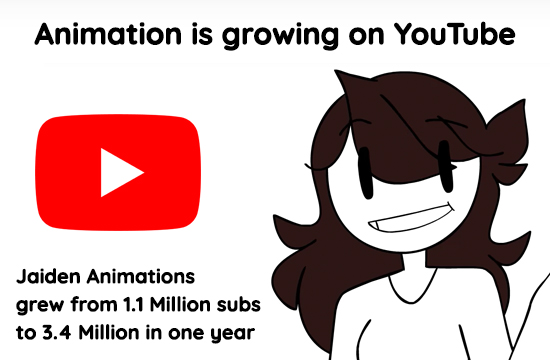- by Lesley Klassen
At the end of each year, YouTube creates their Rewind video that celebrates the videos, people, music, and memes that hit big. For the first time, YouTube featured animators in their Rewind video.
In fact, animation is really growing on YouTube and you can see this at conferences like VidCon, that are seeing more programming devoted to animation.

You may be saying to yourself, “What’s the big deal? Animations are becoming more popular on YouTube, so what.” It all comes down to the YouTube algorithm and the added challenges that animators face over live-action content creators.
If you have an hour or more to spare watch this enlightening video on the YouTube algorithm by the Fine Brothers and MatPat from Game Theorist. There are some great insights to take from this video. Primarily, creators need to post regularly and have videos with longer watch times, preferably over 10 minutes long.

Creating 10 minutes of live-action video is challenging enough, but it’s not nearly as tough as it is to create 10 minutes of animated content on a regular basis. It’s actually damn near impossible. Animation takes a long time.
YouTube made it even harder for animators with the new changes to their monetization policy. Now you need 1000 subscribers and at least 4000 hours of viewership over the last 12 months in order to qualify for their YouTube Partner Program. This means that animators need to create 10 minutes of content or longer on a frequent basis, preferably 2 - 3 times a week, and build a subscriber base of 1000 before even turning on monetization. For many animators, why bother?

Channel Frederator represents over 3000 animators on YouTube and provide services that help YouTubers market their animations. They felt the need to respond to the new YouTube monetization policy. "Channel Frederator Network has decided to allow members of the network, who have been kicked out of YouTube's Partnership Program, to stay and use our tools & resources to help them reach new audiences," states Director of Networks Kenneth Ash.
Animators really do have a dilemma. Especially those up and coming channels who haven't reached monetization. That's the thing about animators, they are so passionate about animating that they will persist for the love of the art. But persistence won’t change the YouTube algorithm, however technology can help.
Flipside Studio is a real-time animation studio. We simulate a film set or TV studio inside virtual reality to allow an animator to use filmmaking techniques along with real-time motion capture to make animated content. Because it’s real-time, it takes about the same amount of time to make a Flipside animation as it takes to record a live-action video. We make it easier to make longer animations more frequently so animators can start competing against live-action creators for subscribers and watch time.
There are multiple strategies animators are using to currently keep pace with the demands of the YouTube algorithm, and we know Flipside can help.
We believe that real-time animation technology will play a big role in the future of animation. This is especially true on competitive platforms like YouTube that have algorithms that play a role in surfacing content. Animators have it tough but new technologies like Flipside are emerging to level the playing field. Sign up for our private Alpha to give Flipside a try.